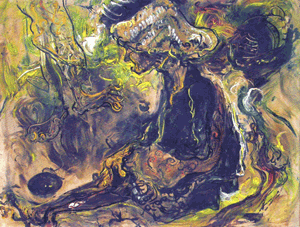 Basuki Abdullah Painting with "Brother and Sister" Strength of Mastery of Realist Technique
Basuki Abdullah Painting with "Brother and Sister" Strength of Mastery of Realist TechniqueBasuki Abdullah Painting with "Brother and Sister "Strength of Mastery of Realist Technique
 Basuki Abdullah Painting with "Brother and Sister" Strength of Mastery of Realist Technique
Basuki Abdullah Painting with "Brother and Sister" Strength of Mastery of Realist TechniqueAbas Alibasyah Painting with "garuda"has Made Renewal by Doing Abstractions at The Paintings.
In a painting titled "Garuda" in 1969, the implementation of the basic patterns to abstract geometric shapes eagle is very dominant. Be unique because the deformation has been so far and eagle forms, so that's more important is the expression of the visual elements of the existing share. Red color with gradations of violet and orange-red Kea give strength as an expressive background. Form of the bird emerges through the construction debris field with yellow and green, tied with a coarse texture and scratches imaged primitive breath. This painting is also like the works of Abas in that period, influenced by the visual sources of various ethnic Statue Archipelago. Abas is the aesthetic attitude, is a concrete embodiment in the process of struggle to defend the values of wave exposure indegeneous in Western culture, wrapped in the euphoria that time modernism.
A.D Pirous Painting in Amparan Roof of Heaven and Earth
In the painting "Amparan open to the sky and Earth" (Surat al-Baqara: 22a), this 1990, Pirous also brings a touch of spirituality. Ultramarine blue background brings a depth image of an infinite cosmos. At the top, sticking out part of the pieces of ocher which imaged a mass of sky. Below, two white field with Qur'anic calligraphy erect a solid foundation for the image of the earth. Among the images of the heavens and the earth were of a similar white line dividing the light vertically through the depth of the cosmos. With a variety of characters that can be read through a textual phenomenon, hence a similar line of light, it can be interpreted as the divine light that connects the heavens and the earth. In other paintings, the artist often build a natural atmosphere to provide a strong background related to the verses of Koran in his paintings. Through fields of preparation, space, and particular colors, the mood in the paintings may reflect the dim twilight, clear morning, or night is serene. Thus we can say that Pirous also managed to develop a symbolic abstract paintings. All the exploitation of ideas, mediums, and those technical finally put Pirous not just as a painter calligraphy reliable, but further reinforces Islamic spiritual accomplishments as a painter
Raden Saleh Painting "Storm"are Dramatic, Emotional, Mysterious, and Imaginary.
The Begger separated from the bottom of empathy in community life
 The Begger separated from the bottom of empathy in community life
The Begger separated from the bottom of empathy in community lifeAffandi's paintings featuring the figure of a beggar is a manifestation of the achievement of a strong personal style. Through ekpresionisme, he melts with the object-object together with the empathy to grow through the process of observation and deepening. Having empathy cook it into energy, it happens in the casting process like a burst of mountain paintings lavanya complete turmoil. In any expression, in addition to the lines of energy raises the overflow lukisanya also record the thrill in the world bathinnya appreciation. In this painting looks frail figure of the beggar who sat waiting for compensation from passersby. Depictions of the body stooped over tendrils flowing lines, emphasizing the suffering expression panhandlers. Dark brown color that builds bodies, as well as accentuating the color of greenish-yellow color as the background, increasingly gloomy atmosphere that is built up to sharpen the overall expression.
But there was gloom, vitality remains strong life can be read through the scratches that describes the motion of some other figures. In the configuration of these objects, dynamic composition. Dynamics were also enriched with spontaneous strokes and textural effects of the rough from plototan paint tubes that produce the power of expression.
Options figure of a beggar as the objects in the painting can not be separated from the bottom of empathy in community life. Fan Affandi was a mawkish, at once full of life adventurer vitalitas.Objek-trashy and common objects always mengguha empathy. Therefore, he is often referred to as a humanist in his art. In various statements and his paintings, he often menggungkapkan that the sun, hands and feet is the symbol of life. The sun is a manifestation of the spirit of life. Hand shows the attitude that hard work and to realize all his ideas. Untkapan feet is symbolic of the motivation to continue to move forward in life. Symbols is indeed the crystallization of life experiences and attitudes Affandi, and process art travel the hard and long. Through the figure of a beggar in this painting, the crystallization of hard life experience and empathy for the suffering that may be unreadable


